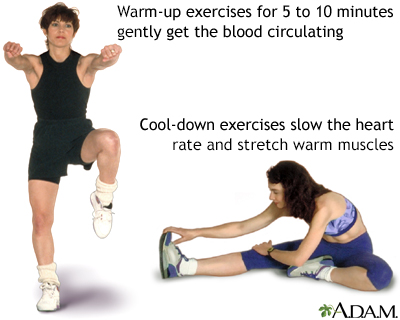| Step 7: Warm up, cool down, and stretch |
Warming up, cooling down, and stretching are an extremely important part of any workout. These steps help your body adjust to changes in activity and, most importantly, help to prevent injury.
Warm up
You should not go from rest one minute to intense exercise the next. Spending a few minutes warming up your body and your muscles before you begin intense exercise is extremely important. By letting your body adjust gradually to the demands of exercise, you avoid injuring your muscles and put less strain on your heart. You may also find exercising easier and, therefore, more enjoyable when you warm up first.
You can warm up with any simple, comfortable movement. Most people find it convenient to warm up by doing their chosen activity at a slower pace. For example, if you are going for a run, you can walk during your warm up.
Cool down
Cooling down after a workout to slow your heart and respiration (breathing) rate back to normal is also very important. The reverse of warming up, cooling down should gradually bring your body back to its resting state. If you don't cool down, your blood pressure may drop too quickly, which can cause dizziness or lightheadedness.
Cool down by slowing your activity, but not stopping it completely. Keep going at the reduced pace for about 5 minutes, gradually slowing down every 1 - 2 minutes, until you are ready to stop.

Don't forget to stretch
Stretch after your warm up and again after your cool down to help your muscles recover from what you have just done. (Don't stretch BEFORE you warm up!) Stretching after exercise is very effective because your muscles are more flexible when they are warm. This helps to avoid injury the next time you work out.
When you stretch, you should just feel a gentle tension in your muscle. You should not feel pain in either the muscle or joint. If you do, ease up the degree of stretch or strain. Hold each stretch for 10 - 20 seconds without moving the muscle. Don't bounce! Bouncing during a stretch may tear the muscle. And remember to breathe, which brings oxygen to the muscles and can help you deepen the stretch safely.
Some muscle groups that are important to stretch include:
Reviewed By: Jeffrey Heit, MD, Internist with special emphasis on preventive health, fitness and nutrition, Philadelphia VA Medical Center, Philadelphia, PA. Review provided by VeriMed Healthcare Network. Also reviewed by David Zieve, MD, MHA, Medical Director, A.D.A.M., Inc.






